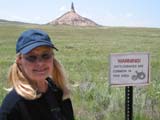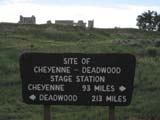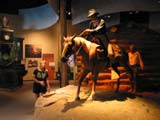 My
favorite period in history is the era of westward expansion to the Rocky Mountains
and beyond. The first organized group of emigrants to settle in the far west
was a small wagon train heading for free land in the valley south of Portland
Oregon. In 1841 that group pioneered a wagon route with plenty of water and
gentle grades crossing the mountains. This route soon became known as the
Oregon Trail. Easy (some would say boring) trails like this had been
shunned by the mountain men who were traveling with pack animals rather than
wagons (and wanted to be in the back-country anyway).
My
favorite period in history is the era of westward expansion to the Rocky Mountains
and beyond. The first organized group of emigrants to settle in the far west
was a small wagon train heading for free land in the valley south of Portland
Oregon. In 1841 that group pioneered a wagon route with plenty of water and
gentle grades crossing the mountains. This route soon became known as the
Oregon Trail. Easy (some would say boring) trails like this had been
shunned by the mountain men who were traveling with pack animals rather than
wagons (and wanted to be in the back-country anyway).
A couple of years after the Oregon migration began, the first half of their route (sometimes referred to as the Great Platte River Road) was being followed by wagon trains looking for free land in California too. In 1847 the Mormons followed a cutoff pioneered by the Donner Party on their way to the Salt Lake valley. Its interesting to note that the Mormons chose to travel on the north bank of the Platte while the main trail was established on the south bank. The last major group to travel the Oregon Trail was the Forty-niners on their way to gold fields in the foothills above the Sacramento valley. That group constituted by far the greatest influx of Oregon Trail travelers. The basic route of the Forty-niners was later followed in 1860-61 by the Pony Express during its short life; before being made obsolete by the transcontinental telegraph. Ultimately, the trail's own popularity sounded its death knell when the route was followed by the transcontinental railroad in 1869. In its short 28 years life, (the first half of) the Oregon Trail had accommodated more than a quarter million travelers.
 The
trail's official starting point depended on the group. Mile Zero could
be one of several points along the Missouri River between Kansas City and
Omaha. Regardless of where they started, though, all trails made a beeline
for the Platte River and followed it west across the plains to present day
Casper Wyoming (mile 750). There it moved to the Sweetwater River and followed
it to an easy crossing of the Continental Divide at South Pass (mile 900).
Another week or two of travel took the pioneers to Fort Bridger (mile 1,000);
the halfway point if going to Oregon or California. There the routes divided,
with the Oregon travelers heading north to the Snake River and everyone else
working their way down to the Great Salt Lake. From there, the California-bound
continued across the bleak Nevada desert to cross the Sierra mountain range
near Lake Tahoe.
The
trail's official starting point depended on the group. Mile Zero could
be one of several points along the Missouri River between Kansas City and
Omaha. Regardless of where they started, though, all trails made a beeline
for the Platte River and followed it west across the plains to present day
Casper Wyoming (mile 750). There it moved to the Sweetwater River and followed
it to an easy crossing of the Continental Divide at South Pass (mile 900).
Another week or two of travel took the pioneers to Fort Bridger (mile 1,000);
the halfway point if going to Oregon or California. There the routes divided,
with the Oregon travelers heading north to the Snake River and everyone else
working their way down to the Great Salt Lake. From there, the California-bound
continued across the bleak Nevada desert to cross the Sierra mountain range
near Lake Tahoe.
In the early years at least, there were only two resupply points on the first 1,000 miles of the trail: Fort Laramie and Fort Bridger. A couple of summers ago we traced a section of the Oregon Trail beginning at Independence Rock (mile 815). We followed the Sweetwater River, crossing South Pass to Fort Bridger (mile 1,000). This year we picked up the trail in Nebraska at Chimney Rock (mile 560). This unique geographic feature was the first major landmark that travelers would have come to after spending well over a month crossing the featureless prairie. Passing by Scott's Bluff, we stopped to explore Fort Laramie National Historic Park (mile 650) before leaving the trail at Casper Wyoming (mile 740).
 We
spent a few hours in Casper at their excellent Oregon Trail Interpretive Center.
It made us reflect on our current situation: pulling an 8' x 32' trailer at
60 mph over paved highways and across bridges, stopping in established campgrounds
with full hookups, and utilizing grocery stores, gas stations and Laundromats
in towns spaced no more than an hour apart. Our counterparts a century and
a half ago were walking beside their 4' x 12' wagon, which was struggling
through muddy ruts, fording fast moving rivers, and being winched over snow-covered
passes. At campsites they often found water contaminated by large groups that
passed through a few days earlier. They were anxiously anticipating resupply
points that were at least 30 days apart, and worrying about fuel for their
oxen in overgrazed or snow covered grasslands. Can I change my favorite period
in history to now?
We
spent a few hours in Casper at their excellent Oregon Trail Interpretive Center.
It made us reflect on our current situation: pulling an 8' x 32' trailer at
60 mph over paved highways and across bridges, stopping in established campgrounds
with full hookups, and utilizing grocery stores, gas stations and Laundromats
in towns spaced no more than an hour apart. Our counterparts a century and
a half ago were walking beside their 4' x 12' wagon, which was struggling
through muddy ruts, fording fast moving rivers, and being winched over snow-covered
passes. At campsites they often found water contaminated by large groups that
passed through a few days earlier. They were anxiously anticipating resupply
points that were at least 30 days apart, and worrying about fuel for their
oxen in overgrazed or snow covered grasslands. Can I change my favorite period
in history to now?